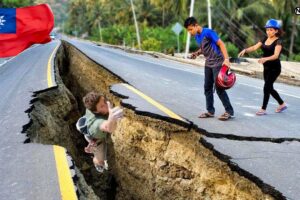
TORNADO IN USA, CAUGHT ON CAMERA| #shorts, #tornado, #disaster, #massivetornado, #catastrophe
MASSIVE TORNADO CAUGHT ON CAMERA| MOTHER TORNADO CRAZY FOOTAGES| SCARY WATER SPOUT| TORNADO IMPACT
A tornado is a violently rotating column of air that is in contact with both the surface of the Earth and a cumulonimbus cloud or, in rare cases, the base of a cumulus cloud.
Tornadoes come in many shapes and sizes, and they are often visible in the form of a condensation funnel originating from the base of a cumulonimbus cloud, with a cloud of rotating debris and dust beneath it. Most tornadoes have wind speeds less than 110 miles per hour (180 km/h), are about 250 feet (80 m) across, and travel a few miles (several kilometers) before dissipating. The most extreme tornadoes can attain wind speeds of more than 300 miles per hour (480 km/h), are more than two miles (3 km) in diameter, and stay on the ground for dozens of miles (more than 100 km).
Various types of tornadoes include the multiple vortex tornado, landspout, and waterspout. Waterspouts are characterized by a spiraling funnel-shaped wind current, connecting to a large cumulus or cumulonimbus cloud. They are generally classified as non-supercellular tornadoes that develop over bodies of water, but there is disagreement over whether to classify them as true tornadoes. These spiraling columns of air frequently develop in tropical areas close to the equator and are less common at high latitudes. Other tornado-like phenomena that exist in nature include the gustnado, dust devil, fire whirl, and steam devil.
Tornadoes occur most frequently in North America (particularly in central and southeastern regions of the United States colloquially known as tornado alley), Southern Africa, northwestern and southeast Europe, western and southeastern Australia, New Zealand, Bangladesh and adjacent eastern India, and southeastern South America. Tornadoes can be detected before or as they occur through the use of Pulse-Doppler radar by recognizing patterns in velocity and reflectivity data, such as hook echoes or debris balls, as well as through the efforts of storm spotters. (SOURCE: WIKIPEDA)
#tornado, #waterspout, #crazyfootages, #caughtoncamera
source







Welcome to tornado alley. I live in AR and filmed one from my front porch like an idiot in March.
It literally never killed anyone.
Andover Kansas EF3 tornado on April 9, 2022. Max. winds: 165 Mph. Width: 440 yards. Path length, 12.75 mi. Injuries: 4. Killed: 0.
This is with out a doubt the craziest tornado video ever, it looks like a movie with model homes, the destructive power is horrifying…